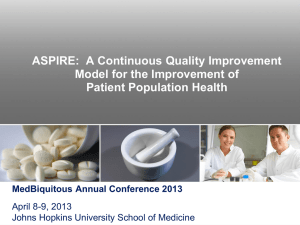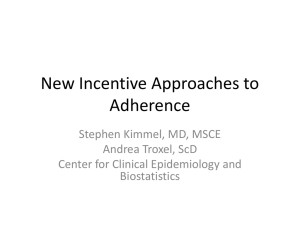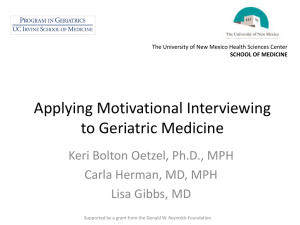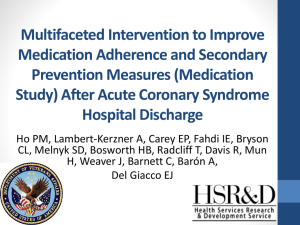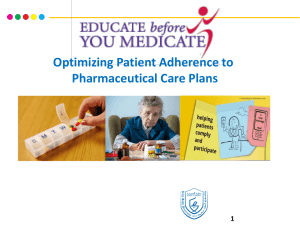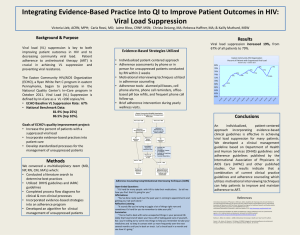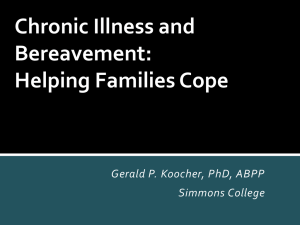presentation slides - National Forum for Heart Disease
advertisement
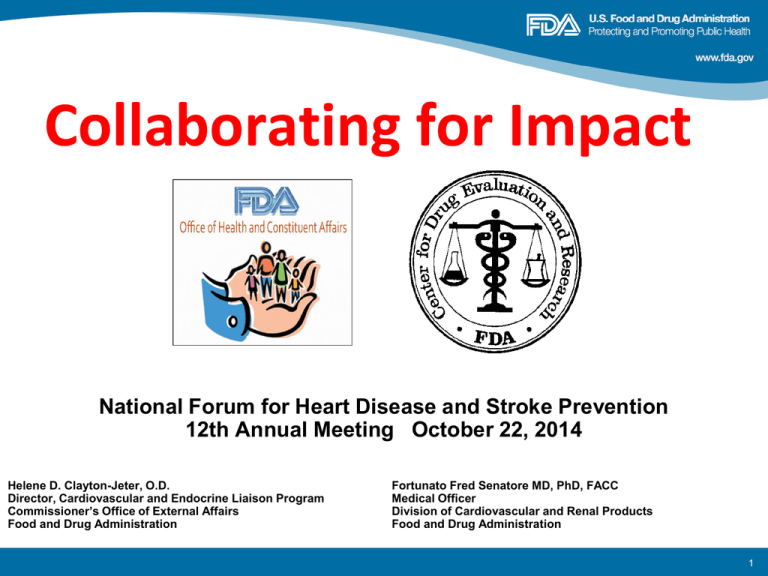
Collaborating for Impact National Forum for Heart Disease and Stroke Prevention 12th Annual Meeting October 22, 2014 Helene D. Clayton-Jeter, O.D. Director, Cardiovascular and Endocrine Liaison Program Commissioner’s Office of External Affairs Food and Drug Administration Fortunato Fred Senatore MD, PhD, FACC Medical Officer Division of Cardiovascular and Renal Products Food and Drug Administration 1 Presenter Disclosure The opinions and content in this presentation are based on personal views and do not reflect positions or policies of the FDA. 2 Million ® Hearts Goal: Prevent 1 million heart attacks and strokes by 2017 • National initiative co-led by CDC and CMS • In partnership with federal, state, and private organizations innovating and implementing • To address the causes of 1.5M events and 800K deaths a year, $312.6 B in annual health care costs and lost productivity and major disparities in outcomes From presentation by Janet Wright, MD, FACC, Executive Director, MH Initiative 3 Key Components of Million Hearts® Excelling in the ABCS Optimizing care Health Keeping Us Healthy Disparities Changing the context Prioritizing the ABCS Health tools and technology Innovations in care delivery TRANS FAT From presentation by Janet Wright, MD, FACC, Executive Director, MH Initiative Million Hearts • Three things must happen to prevent 1 million heart attacks and stroke – 6.3 million smokers quit – 10 million more people control their hypertension – 20% reduction in sodium intake Focus on populations with greatest burden and at greatest risk From presentation by Janet Wright, MD, FACC, Executive Director, MH Initiative 5 Preventing a Million: Targets for Our Environment 2009-2010 Pre-Initiative Estimate 2017 Target 26% 10% reduction Sodium reduction 3580 mg/day 20% reduction Trans fat reduction 0.6% of calories 100% reduction Intervention Smoking prevalence From presentation by Use Janet Wright, MD, FACC, Executive Director, MH Initiative National Survey on Drug and Health 2009-2010 National Health and Nutrition Examination Survey 2009-2010 Preventing a Million: Targets for the ABCS Intervention 2009-2010 Pre-Initiative Estimate 2017 Populationwide Target 2017 Clinical Target Aspirin when appropriate 54% 65% 70% Blood pressure control 52% 65% 70% Cholesterol management 33% 65% 70% Smoking cessation 22% 65% 70% National Ambulatory Medical Care Survey, National Health and Nutrition Examination Survey Government/ Academia FDA Medication Adherence Strategies Partnering For Public Health Scientific Research Improved Healthcare and Care Delivery Patients/Societies/Payers 8 Collaborating for Impact Assess, Address, and Reduce Health Disparities 9 FDA Action Items to support Million Hearts Translate and Disseminate Knowledge Implement and Innovate for Population Health Research* Liaison program, newsletters, and webinars targeting CV health practitioners, patients, patient advocates, and consumers Nutritional Fact Label Campaign •Label Youth Outreach •Menu and Vending Enhanced adherence strategies for CV meds Link MH website with FDA’s CV webpage. Conduct “the real cost” tobacco cessation program Evidence synthesis focused on improved patient outcomes Publication: •sodium levels for food •partially hydrogenated oils are not generally recognized as safe * Response to the challenge to “push the envelope” 10 Adherence: Multifaceted faceted issue Convenience Pill Burden/Day Cost of drugs TI Adherence Rescue Therapy Patient Attitude and awareness Test for Adherence PCP-Patient Relationship Symptom of Disease Health Equity TI = Therapeutic Index 11 Research Action Item-MH Outcome Metrics Alliance Rescue Therapies Professional Academies and Colleges Evidencesynthesis on improved patient outcomes Strategy for enhanced adherence TI Pill burden Increased public / sector awareness Improved Care Delivery ACL and Administration on Aging TI = Therapeutic Index; ACL= Administration of Community Living 12 Why is adherence important? • Assessing the Impact of Medication Adherence on Long-term Outcomes Post Myocardial Infarction – Bansilal S, Castellano JM, Wei HG, Garrido E, Freeman E, Spettell CM, Garcia-Alonso F, Steinberg G, Sanz G, Fuster V; ESC Congress 2014 • Outcome: Time to MACE (death, hospitalization for MI, stroke, coronary revascularization) by Adherence Levels (Portion of Days Covered for both statin and ACE-I as determined by prescription pattern x 6 months 13 Time to MACE by Adherence Levels 14 Collaborating for Impact • Conclusion – Million Hearts promotes collaboration in CV risk modification involving ABCS – Million Hearts involves a multitude of government agencies each tasked with specific action items – Mechanisms to enhance medication adherence being examined 15 For additional information, contact the Commissioner’s Office of External Affairs, Office of Health and Constituent Affairs, Million Hearts Liaison Helene Clayton-Jeter, O.D. at cardio.endocrine@fda.hhs.gov or 301.796.8452 16 Collaborating for Impact Back-up 17 Assessing the Impact of Medication Adherence on Long-term Outcomes Post Myocardial Infarction S. Bansilal, JM. Castellano, HG. Wei, E. Garrido, A. Freeman, CM. Spettell, F. Garcia-Alonso, G. Steinberg , G. Sanz, V. Fuster European Society Of Cardiology Congress 2014 Bansilal et al, ESC 2014 18 Adherence Study-Background • Evidence based medications for secondary prevention of cardiovascular disease (CVD) have led to a 50% reduction in mortality • Nearly half of the patients are non adherent within the first year post event. • Long-term studies linking adherence with outcomes are limited. • We attempted to study the association between levels of medication adherence and long-term major adverse cardiovascular events in patients post myocardial infarction (MI). Bansilal et al, ESC 2014 19 Adherence Study-Objectives • Evaluate the association of levels of medication adherence with long-term major cardiovascular events- death, hospitalization for MI, stroke and coronary revascularization. • Evaluate the association of levels of medication adherence with ‘softer’ cardiac outcomes – hospitalization for angina, All-cause and cardiac –related visited to ED. • Evaluate the association of levels of medication adherence with resource utilization- outpatient visits to a cardiac specialist and cardiac testing. Bansilal et al, ESC 2014 20 Adherence Study-Methods • 2010-2013 data from Aetna Commercial & Medicare Advantage population databases • Enrolment records, medical and pharmacy health insurance claims. • Records linked for comprehensive tracking of individuals’ use of healthcare resources and clinical outcomes over time and across providers. • Symmetry Episode Risk Groups (ERG®) Scores & publicly available data from the U.S. Census 2010 file used Bansilal et al, ESC 2014 21 Adherence Study: Inclusion/Exclusion Inclusion Criteria: • Adults who initiated both statin and ace-inhibitor (ACEI) medications following a hospitalization discharge for myocardial infarction (MI) based on ICD codes with a length of stay of more than 2 days, between January 1, 2010, and February 28, 2013. • Continuous eligibility for both medical and prescription drug benefits from Aetna during 6 months before and after the MI. Exclusion Criteria: • Pregnant • Diagnosis codes indicating psychoses, dementia, bipolar disorder, major depressive disorder (severe with psychotic behaviours) or alcohol/substance abuse • Living in a nursing home or in a hospice or respite care. • Patients who had a refill for ARB medication within 6 months following the discharge date of the MI Bansilal et al, ESC 2014 22 Adherence Study: Endpoint Selection • Most recurrent events post MI occur within the first year • Patients ‘reveal’ their adherence patterns as early as a month post MI, but their stable pattern is best apparent around 6 months and beyond • Studies evaluating adherence have typically selected a 6-12 month exposure period • We chose a 6 month adherence assessment period to optimize rigor while maintaining power 1. Smolina K et al. Circ Cardiovascular Qual. Outcomes 2012 2. Ho PM etal.- Arch. Int Med 2006 ; Am Heart J 2008; Circulation 2009 3. Jackevicius CA et al. Circulation 2008 4. Choudhry NK et al. Am Heart J 2014 Bansilal et al, ESC 2014 23 Adherence Study: Assessment • Proportion of days covered (PDC) for both statin and ACEI during 6 months of follow-up after the index prescription. • Patients were considered to be adherent if they were getting the refill of both ACEI and statin prescriptions. • Based on their PDCs, we categorized patients into one of three groups using standard thresholds: ≥80% (‘fully adherent’), 40–79% (‘partially-adherent’), and <40% (‘non-adherent’). Bansilal et al, ESC 2014 24 Adherence Study: Statistical Analysis • Descriptive analyses were conducted to compare baseline characteristics between adherence exposure groups. • Time to MACE for the three exposure groups was compared using Cox Proportional Hazards regression. • Adjustment for significant confounders including those related to the “healthy adherer effect”. • Event counts were compared using Negative Binomial regression with adjustment for confounders as above. Bansilal et al, ESC 2014 25 Adherence Study: Covariates for adjustment Category Sociodemographics Copayment and medication use Use of medical services Comorbidities Comorbidity scores Variables Age, gender and race/ethnicity. Health plan type (HMO vs. PPO), commercial or Medicare. Estimated household income, population density, region and type of area (rural, suburban, and urban) based on geographic location. Statin, ACE-I and other medications average and total co-payment during the adherence period; ACE-I, ARB, statin, beta-blocker, clopidogrel and warfarin use and all medications use before index date and during the adherence period, generic and mail order use for index medications. Primary care physician or specialist visits, cardiologist visits or visits for cardiovascular testing, influenza vaccination use, length of stay for index MI. Diabetes, hyperlipidaemia, hypertension, depression, cerebrovascular disease, chronic heart failure, ischemic heart disease, obesity, chronic renal failure, chronic obstructive pulmonary disease, atrial fibrillation, metabolic syndrome, peripheral vascular disease, ventricular arrhythmia, previous diagnostic of coronary arterial disease. Symmetry Episode Risk Group® (ERG®) score, Charlson comorbidity score. Bansilal et al, ESC 2014 26 Adherence Study: Disposition 1331 excluded • 29% mental disorders • 1% pregnant/deliv ery • 10% Hospice • 23% Nursing facility • 33% ARB fill during 6 months post MI • 4% MI was not index event Adults post- MI 1/10/10-2/28/13 N=14,119 Adults post MI with ACEI and Statin fill within 6 month post event N=7107 7012 (49.6%) No fill of both ACEI and Statin during 6 months post MI Adults post MI with ACEI and Statin fill within 6 month post event, No exclusion N=5776 Adults post MI with ACEI and Statin fill within 6 month post event, No exclusion, with 6 mth preperiod 1761 without 6 months pre-period N=4015 Fully-Adherent (>80%) N=1721 (43%) Partially-Adherent (40-79%) N=1031 (31%) Bansilal et al, ESC 2014 Non-Adherent (<40%) N=1263 (26%) 27 Adherence Study: Baseline Characteristics Low PDC Mid PDC High PDC p value Age (mean) Male gender (%) PDC (mean) Diabetes (%) 56.6 74.01 21 34.05 57.8 76.72 62 34.20 56.2 79.31 93 25.63 0.0002 0.005 <0.0001 <0.0001 Hyperlipidemia (%) 91.76 94.62 95.41 0.0003 Hypertension (%) Previous CAD (%) Previous CVD (%) Previous PAD (%) 68.19 31.30 5.92 7.57 77.12 34.52 7.21 8.79 68.97 21.50 5.69 5.75 <0.0001 <0.0001 0.215 0.006 Obesity (%) CHF (%) CRF (%) Prospective risk score (ERG) (mean) 4.46 20.66 4.17 2.96 5.78 20.43 5.86 3.29 4.65 17.26 3.78 2.50 0.259 0.033 0.021 <0.0001 Charlson Comorbidity Score (mean) 1.91 2.04 1.82 <0.0001 4.2522 64336 488 4.5701 66058 570 4.0622 66827 592 0.0084 0.031 <0.0001 Length of Stay - Index Admission (mean) Household income in zip code (median) Copays for all medications during adherence period (mean) Bansilal et al, ESC 2014 28 Adherence Study: Time to MACE by Adherence Level Bansilal et al, ESC 2014 29 Adherence Study: Primary Outcome Measures Event Low PDC (N=1031) Mid PDC (N=1263) High PDC PDC group Ratiop value (N=1721) comparison Composite Cardiac Events 18.1 (281) 17.2 (329) 12.8 (328) High v. Low 0.72 0.002 High v. Mid 0.81 0.01 Mid v. Low 0.90 0.18 Coronary/MI Hospitalization 4.8 (74) 4.4 (84) 2.3 (58) High v. Low 0.54 0.001 High v. Mid 0.59 0.01 Mid v. Low 0.90 0.57 Stroke Hospitalization 1.2 (18) 0.9 (17) 0.6 (16) 0.09 0.86 0.14 0.01 Revascularization Procedures 14.4 (224) (IP or OP) 13.1 (249) High v. Low 0.54 High v. Mid 0.94 Mid v. Low 0.58 10.8 (277) High v. Low 0.78 High v. Mid 0.86 0.12 Mid v. Low 0.90 0.30 Bansilal et al, ESC 2014 30 Adherence Study: Limitations • Insurance and pharmacy claims database • Lack of benefit for secondary outcomes • Overlap of outcomes with the adherence assessment period • Unable to directly establish causality • Confounding bias • Treatment initiation Bansilal et al, ESC 2014 31 Adherence Study: Conclusions • High levels of adherence to guideline recommended therapies are associated with a lower rate of major cardiovascular events compared to partial or nonadherence. • There appeared to be a threshold effect for this benefit at >80% adherence. • Novel approaches to improve adherence such as a polypill that may enable >80% adherence with secondary preventive therapies may lead to a significant reduction in CV events post MI. Bansilal et al, ESC 2014 32

